This Seville travel guide will introduce you to everything you need to know to eat well, save money, and see the sights Seville provides!
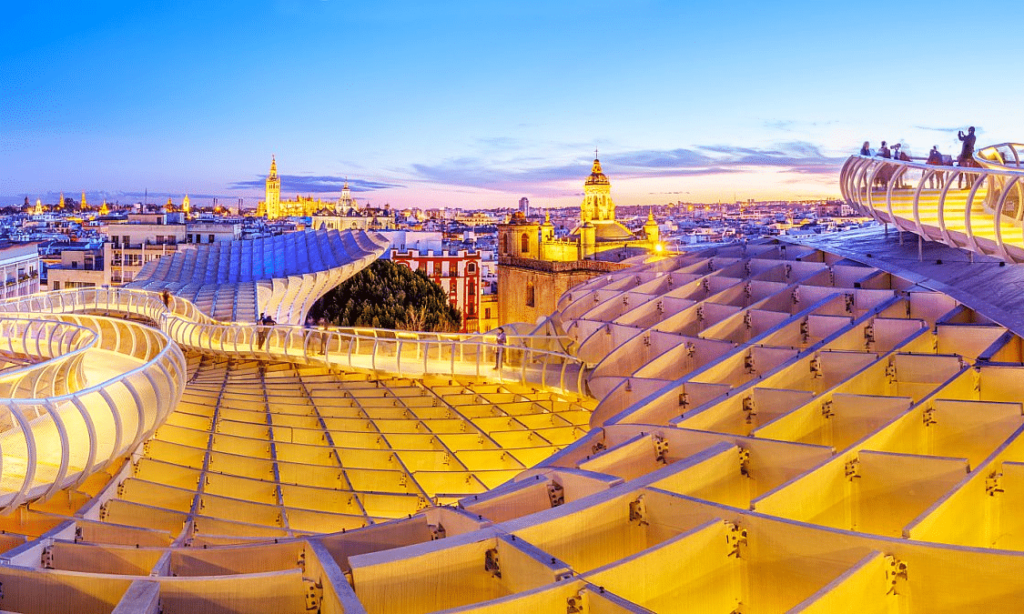
©sevilla.abc.es
Our website includes affiliate links. So, remember that we may receive commissions when you click our links and make purchases. Please read our legal disclaimer document for more information about our Affiliate disclaimer and other disclaimers like the Fair-Use disclaimer.
Short intro to our Seville travel guide
Welcome to our Seville travel guide! The city is the capital of the Spanish region and province of Andalusia. It has about 750,000 inhabitants, making it the fourth-largest city in Spain. Seville is the most critical southern Spanish city in the cultural, political, economic, and artistic realms. It offers many attractions, such as the Real Alcázar de Sevilla, the Seville Cathedral with the Giralda Tower, and the Torre del Oro at the river. Furthermore, Seville is the most important historical center in Europe.
In conclusion, considering all the Arabic influences, the narrow winding streets, parks, and the large historic center (Barrio de Santa Cruz). This stunning city lies on the banks of the Guadalquivir River. Thanks to the many historical highlights, Seville is often seen as the most beautiful city in Andalusia and Spain. More importantly, the Barrio de Triana, a district of Seville, Spain, is seen as the birthplace of flamenco, the typical Spanish dance and music. And lastly, Seville is famous for its Mudéjar architecture, a mix of Islamic and Catholic architectural styles. After the Catholics defeated the Moors, who had ruled over Seville for more than 500 years, they kept many beautiful buildings, like the Alcazar Palace. Sometimes, they gave it their Catholic twist, like the Cathedral with the Giralda.
Seville is a big university town and is extremely popular with people studying abroad. This makes it a more affordable destination than cities like Barcelona or Madrid (and less crowded, too).
So, let’s go to the Top things to see and do in Seville.
Top Things to See and Do in Seville

©sevilla.abc.es
Check out Plaza de España
One of Seville’s most picturesque spots, Plaza de España, was built at the northern edge of the Parque de María Luísa in the 1920s for the Ibero-American Exposition. The unique building mixes Baroque, Renaissance, and Moorish architectural styles, and there’s a small canal with Venetian-like bridges. The murals along the sweeping arc of the building depict the various regions and municipalities of Spain. Furthermore, it also has benches representing 49 provinces of Spain in ceramic tiles. The Plaza has gotten much attention in the past few years because it has served as a backdrop in film and TV, such as Star Wars and Game of Thrones. Admission is free.

©dosde.com
Visit the Royal Alcázar
The Royal Alcázar of Seville (also known as al-Qasr al-Muriq) is the oldest residential palace in Europe and is still used today. It is an example of Moorish architecture dating to the 14th century. The palace has giant galleries, ornate rooms, and beautiful gardens. It was built for the Christian king Peter of Castile after Christian armies reconquered the city in 1248. More importantly, it is also a UNESCO World Heritage Site.
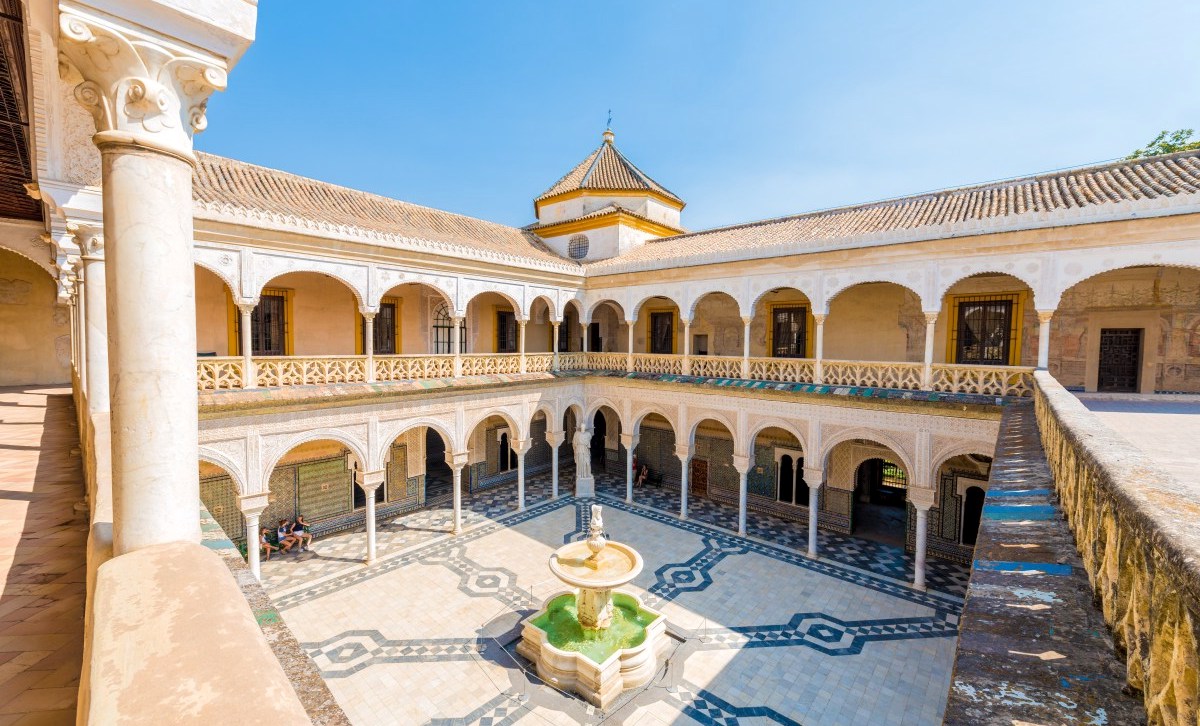
©tegustaviajar.com
Tour Casa de Pilatos
This beautiful Andalusian palace, built in the 16th century, merges Italian Renaissance and Spanish Mudejar styles. It houses a collection of 16th and 19th-century paintings and a sculpture garden of Greek mythological figures. Moreover, it’s also the permanent residence of the Dukes of Medinaceli (a hereditary title in Spain). It boasts the world’s most extensive collection of azulejo (a traditional glazed tile artwork). Numerous films have also been shot here, including Lawrence of Arabia, Kingdom of Heaven, and Knight and Day, to name a few.

©itinari.com
Cool down in Parque de Maria Luisa
Located just in front of the iconic Plaza de España, this public park is a relaxing place to cool down in the summer while browsing its gardens, patios, and sculptures. Located near the Guadalquivir River, it is Seville’s central greenspace. Created in 1911, it is a lounge, picnic, and people-watch place.
Visit the Catedral of Sevilla
Surrounded by Andalusian orange trees, the Cathedral (of Saint Mary of the Sea) is one of Seville’s top tourist attractions. This Roman Catholic Cathedral dominates much of Seville’s skyline. While you can admire the stunning design and stained glass from the outside, the Cathedral’s interior houses Christopher Colombus’s grave, so it’s worth going inside.

©mercerhoteles.com
Climb the Giralda for unbeatable views of Seville.
An icon of Seville’s elegant skyline, the Giralda glows golden against the blue sky that stretches above Andalucía nearly all year round. The scalloped archways and Islamic decoration on the lower section show Giralda’s origins; it was formerly the minaret of the 12th-century mosque. We suggest climbing the 35 ramps and flight stairs during the morning while it is excellent. It’s worth the effort; at the top lie 24 mighty bells and panoramic views of Seville, with the misty outline of the Sierra Norte mountains in the distance.
General Archive of the Indies
Next to the Cathedral and the Alcázar of Seville, the General Archive of the Indies ( Archivo General de Indias in Spanish) is another less touristy place worth visiting.
The visit is free, and the main interest is the remarkable architecture of the building. The inside is gorgeous! However, only expect to see the famous archives. Yes, all the cardboard files in the libraries are empty!
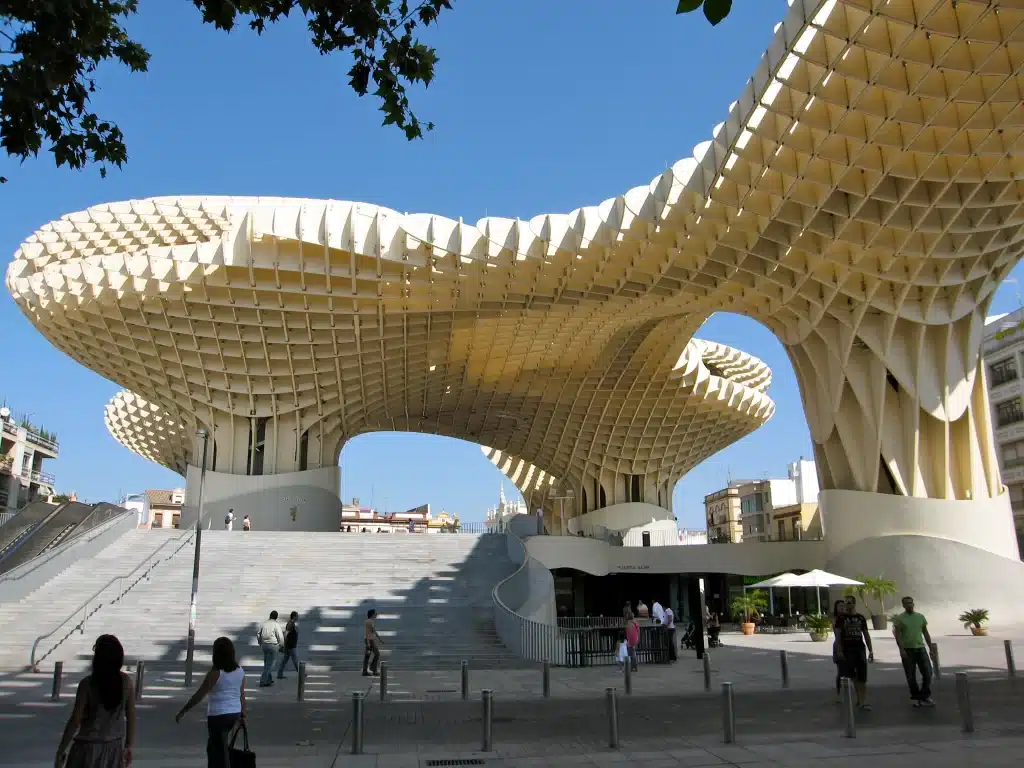
©criticalista.com
Take in the view from the top of a mushroom.
“Las Setas” (mushrooms), as the Metropol Parasol is locally known, act as a contemporary offset to Seville’s centuries-old architecture. There are no Gothic archways here; instead, a showy, modernist structure built entirely from wood – one of the largest in the world – sits atop a Roman and Moorish archaeological site. Meander through the vast cuboid design via rooftop walkways at sunset, when the futuristic timber lattice is lit up, before settling down to sip a caña in the Plaza de la Encarnación, a buzzy former market square.
Hang out in Alameda
The best nightlife spot in Seville is in and around the Alameda de Hercules. The large, open-air Plaza attracts many students and creative artists who relax here, drinking, playing music, and enjoying tapas, bars, and outdoor seating that line the mall. Many of the restaurants and bars in the area offer live music and great deals on food and drinks, too.

©beaire.com
Relax in the Arab baths.
After the glow of Seville’s sunny squares, the candle-lit depths of the Baños Árabes offer instant relaxation. Like much of the city’s architecture, communal bathing dates back 700 years to when Seville was the seat of Moorish force. Then, Muslims would cleanse by moving through a series of marble pools before seeking purification of the spiritual sort in a nearby mosque. Today, the experience is slightly less authentic but no less satisfying. The steam, scrub, and soak ritual is heavenly at Aire Baños Árabes – spa baths housed inside a grand 16th-century Mudéjar palace. After swimming through the thermal circuit beneath cavernous ceilings bedecked with bronze lanterns, head up to the roof terrace for a view over the medieval Cathedral and bell tower. More importantly, it is one of Seville’s most romantic activities; reserve a ticket at dusk before a late-night meal.
Make day trips from Seville.
The perfect Seville travel guide couldn’t exist without offering you some excellent day trips from the city.
So, you can visit most of Seville’s sights in two or three days. But, if you stay longer in the city, you can also use the city as an excellent base to visit other highlights of Andalusia. Being loved are these day trips to the Pueblos Blancos or the typical white villages such as Zahara de la Sierra and Ronda. But you can also take day trips to Córdoba with the Mezquita, to Granada with the Alhambra, the English colony Gibraltar, the sherry capital Jerez de la Frontera, or for the particular hiking trail of El Caminito del Rey.
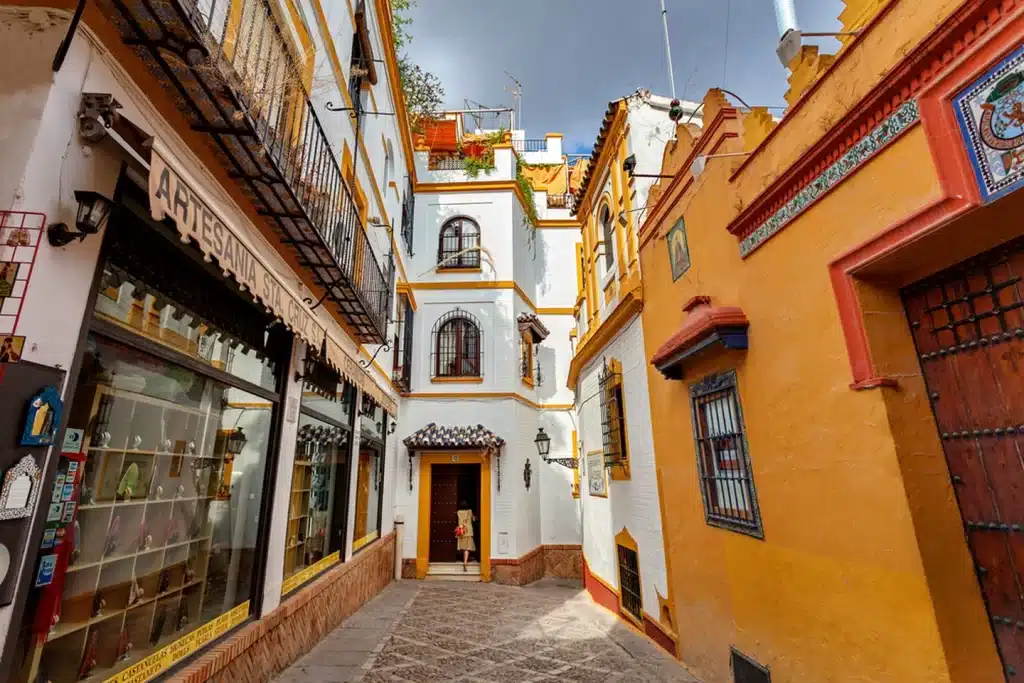
© Irina Sen / Shutterstock
Walk through the historic Santa Cruz district.
The historic and magnetic Jewish quarter of Seville, Santa Cruz, is a maze of narrow alleys and retro plazas waiting to be explored.
Once home to the city’s thriving Jewish community, Santa Cruz has kept its cultural origin.
More importantly, the neighborhood is much more than just a Jewish quarter; it’s also home to some of the city’s primary shopping strip markets and several significant architectural gems—all of which are best appreciated under the tutorship of a local guide on a (free) walking tour!

©notjustatourist.com
Feast on tapas in Seville’s best restaurants
Seville is the epicenter of tapas, the small plates that have become one of Spain’s most prolific exports. More than 3,000 tapas bars hide along Seville’s streets. Some are traditional affairs of wood, tiles, and servers that could be as old as the bar itself; others are showier and more modern. Feast on Andalucían classics such as pescaítos Fritos (deep-fried fish) or artichokes with jamón.
Locals may fight over who does the best acorn-fed jamón ibericó bellota in Seville. Still, everyone agrees that the wafer-thin slices of the cured, salty meat are delectable at Casa Román, a 19th-century institution on the Plaza Venerables. But, if you tire of the platters piled high with fried slivers of berejenas (aubergines) and casseroles of chickpeas and spinach, then make your way to La Brunilda. In this unassuming, whitewashed building, inventive cuisine is beautifully served.

©tripsavvy.com
Visit Spain’s most important bullring
Whether you think bullfighting is spectacle or cruelty, as any native will tell you, it is woven deeply into the heart of Andalucía. Though many people fundamentally disagree with blood sports because of animal cruelty, it’s worth trying to understand this quintessentially Spanish tradition, which the European Union protects. We recommend taking a guided tour around La Corrida La Maestranza. A small exhibition explains the history of the Plaza del Toros (bullring) and how the heart-stopping “la fiesta Brava” works.
Dance in fiery festivals of Sevillian culture
Accommodation costs will hike up during Seville’s annual “Feria de Abril.” However, the joyful week is still worth discovering. The festival is one of Andalucía’s most important. Sevillanas stroll the streets in traditional dress or mounted on horseback. In July, the revelry returns to Triana for its 400-year-old festival. During festivals, much of the entertainment takes place outdoors, free of charge.
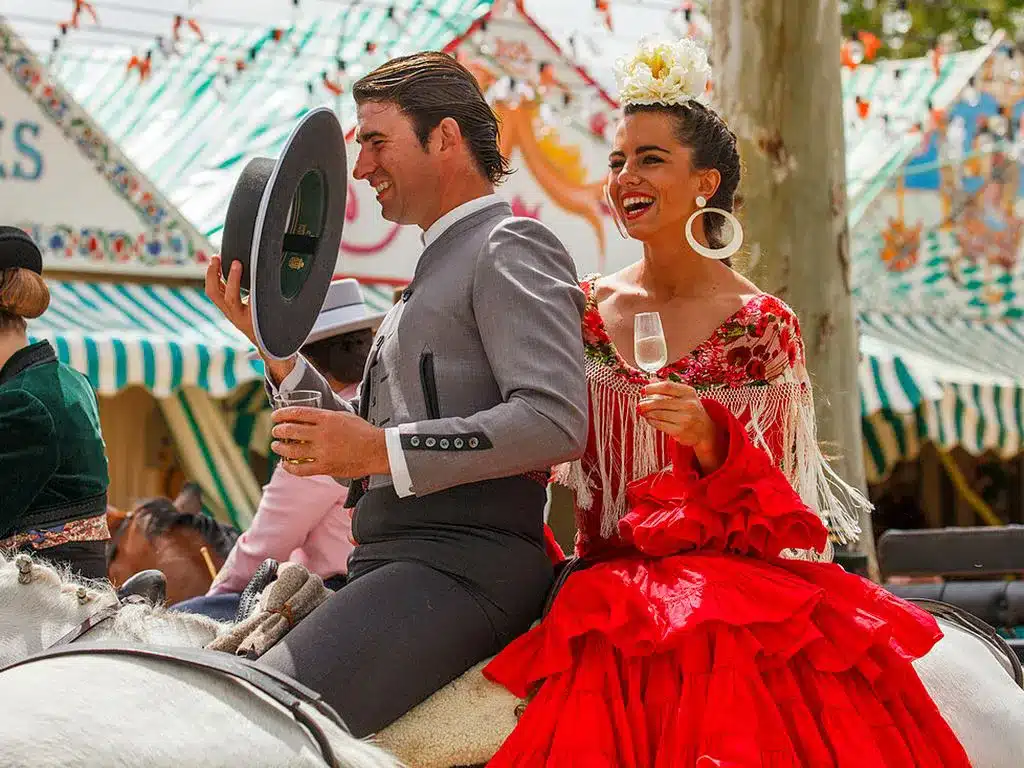
©visit-andalucia.com
Experience Flamenco shows in Triana
What is it? Triana is a traditionally humble neighborhood across the Guadalquivir that retains authentic charm despite recent upscaling. Long famous for its ceramics (check out the Centro Cerámica museum) and flamenco taverns, its riverfront bars are perfect for cooling off on hot summer nights. Raw, passionate, and utterly hypnotic, Flamenco in Seville is rooted in Triana. The typically working-class neighborhood was originally home to the Roma community, who migrated from Eastern Europe in the 15th and 16th centuries.
Private Flamenco shows at night are the most powerful; let the frenzy transport you to Triana’s CasaLa Teatro. Close to the Cathedral, shows in La Casa del Flamenco unfold between Mudéjar arches. Finally, for something simpler, try the tiny Casa de la Guitarra.
Tip: Furthermore, please visit Seville during the biennial of Flamenco to witness its extreme art form at its best. It is when the streets come alive with maestros and baillarinas stamping their feet and whirling shawls as mournful seguiriyas fill the air.
Bar Lola de los Reyes
What is it? This spacious tavern, run by the eponymous Lola, is one of the best places to see authentic flamenco. Located in Triana, flamenco’s heartland in Seville, it has no microphones or frills, but Lola has a voice that will give you goosebumps.
Why go? Seville has many places to see flamenco, including many tourist-oriented tablaos (the Tablao El Arenal is good). But if you want something accessible yet intimate, head to Lola’s in Triana, where a mix of locals and visitors soak up the Duende.
How to get to Seville
Seville’s San Pablo airport (SVQ) is 10 km northeast of the city center. It offers direct flights to 20 destinations within Spain and over 50 destinations in Europe and Northern Africa.
The next closest airport of Malaga is 204 km away = 2h 15min by car.
You can continue to Seville by plane, train, or bus. The high-speed train takes a similar amount of time as the plane. However, getting from the airport to the train station would be best. If you come from overseas, you will probably fly to Madrid or Barcelona. Check both schedules and prices and see which works best for you.
From the airport to the center of Seville
Seville Airport lies around 9 kilometers east of Seville. To go from the airport to the center of Seville, you have these options:
Shuttle Bus EA: The Aeropuerto Especial is a shuttle between the airport and the center.
Taxi: The taxi will take you from Seville airport to the city center in 15 to 20 minutes for a fixed price (about € 30).
Private airport transfer: If you want to book a reliable taxi without stress, you can book it before your trip. The taxi driver will then pick you up from the airport.
Tip: The Seville Travel Card already included an airport transfer.
How to Get Around Seville
Seville’s many tourist neighborhoods, or barrios, are all close and can be easily walked. However, since it gets super warm in the summer, taking the bus or tram is much more comfortable.
- Public transportation—An extensive bus network operates in Seville. You can buy tickets on board. The bus can help you get from one edge of the city to another. The Seville tram system connects to some of the further out areas of the city (and it’s air-conditioned). The tram is part of the same public bus system, so ticket prices are similar.
- Bicycle Rental—Bike rentals are a great way to save money while seeing the sights from a new perspective. In Seville, rentals cost around 15 EUR per day.
- Taxis—Taxis start at 2.50 EUR, with a standard tariff of 1 EUR per additional kilometer. Skip them if you can, as the prices add up fast!
- Ridesharing: Uber is available in Seville, but it won’t save you much, so skip it and stick to the bus.
- Car rental—You can rent a Seville vehicle for as little as 25 EUR daily. However, you don’t need a Seville vehicle unless you plan to leave the city and explore the region. Renters must be at least 21 and have an International Driving Permit.
- Seville Hop on Hop off Bus: It’s a convenient and quick way to see all the sights, especially the ones that are a bit more on the edge of the old town. The route along the 14 stops takes 75 minutes, and the bus runs every 30 minutes. You can get in and out 24 hours between 10 am and 9 pm.
When to Go to Seville
Like most of southern Spain in Andalucía, Seville has a lot of sunshine and hot summers. The best time to visit is between March and May when crowds haven’t peaked and the weather is still warm and sunny.
The Easter season is trendy in Seville because of the well-known Feria (a large fair), which attracts thousands of tourists and pilgrims. The Feria is part of the Semana Santa holy week, and it’s a beautiful time to visit because of the colorful dresses, many street activities, and parades. Still, it does get crowded and expensive during the holy week.
In the summer (June-August), the weather is hot and sunny, with daily highs reaching upwards of 38°C. While the city is lively during the summer, exploring in the heat can be very taxing.
Winter (December-February) offers more comfortable temperatures, usually around 7-18°C. The city is much more peaceful, making it an excellent time to visit if you want to beat the crowds and don’t mind some chilly days.
How much time do you spend in Seville?
We recommend three days in Seville; however, you could easily stay longer.
Two days would allow you to see most of the main attractions if you only have a weekend – and Seville is a great European weekend. However, it’s probably not enough time to fully absorb the Spanish culture that makes Seville such a great place to visit.
In three days, you could catch most of the main sights, allow some time to stroll the streets, try a selection of tapas bars, and enjoy more of Seville’s incredible art scene. We have a full itinerary for three days in Seville, which includes how to see everything as efficiently as possible.
Tip: If you have only a day for the city and have also visited Granada, you can skip the Alcazar and visit other attractions. Why? Not because Alcazar isn’t worth seeing, because it is. But it is also very similar to Alhambra in Granada. However, the latter is still more beautiful.
Where to stay in Seville?
Seville has a wide range of budget hotels, luxury hotels, and B&Bs. For a successful city trip, we recommend finding a hotel in or around the historic center of Seville so that you have all the sights within walking distance. You can experience the atmosphere of Seville (especially in the evening). Alternatively, you can also choose the Triana district, a cozy neighborhood across the river close to the center, and the prices are usually lower there.
Seville travel guide – final words
Seville is truly one wonderful city. Therefore it should be a must-see on every Span or Andalusia trip. Not just the architecture is spectacular, but people too. They are exceptionally friendly and unique. So we recommend the trip.
Note: if you have any questions regarding your planned trip to Seville, don’t hesitate to ask us in the comments below. We’d love to help you.
Take a look at
References and sources:
Photo credits:
Feature photo credits: ©sevilla.abc.es



